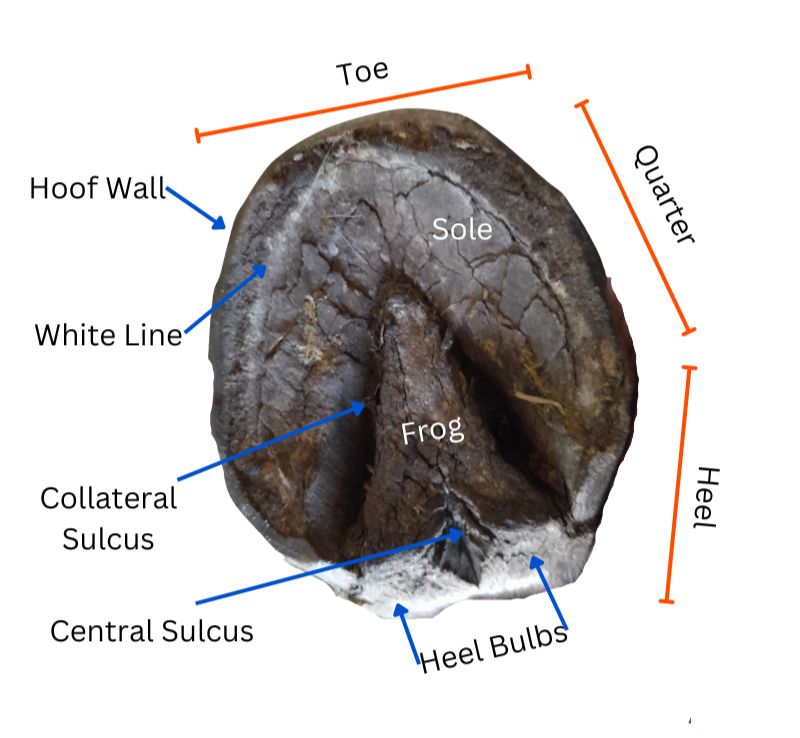The Hoof and the Environment
This publication is intended to help Florida horse owners care for their horses’ hooves.
The hoof of a horse is responsible for bearing weight, resisting wear, absorbing shock, and assisting in blood flow back up the limb to the heart. Each hoof is the support mechanism for the limb above it, and when you consider the sheer size of a horse in comparison to their hooves, this is impressive. Maintaining the health and integrity of the hoof structures is critical to the overall health of the horse.
There are many structures that make up the foot (Figure 1), and they work in concert with one another to support locomotion of the horse. When one structure begins to fail, you often see a domino effect and the resulting lameness of your horse. Additionally, many factors play a part in overall hoof health; genetics is one of the biggest factors and requires careful attention. This is a “non-negotiable” factor and one that you take as it is dealt to you. There are many genetic lines of horses that are known for certain features; stick to the features that do not affect structural soundness. Two other factors in hoof health — environment and nutrition — are somewhat controllable.
The environment can bring about dry or wet conditions, which cause a response in the hoof. Too much of either extreme is not ideal. Moisture is necessary to maintain hoof quality, and hooves are constantly losing water, so water is brought in systemically from blood and lymph supplies of structures in the hoof or environmentally from the ground. There are many products on the market to both moisten and protect the hoof from excessively moist or dry conditions. Keeping the environment clean and dry is also necessary for healthy hoof maintenance.
Nutrition is a major driver of overall horse health, but hoof health and hoof size are directly correlated to nutrition. Balanced nutrition is essential for horse hoof health. A balanced diet should include ample energy, protein (amino acids), vitamins, and minerals (Williams 2022). Deficiencies and excesses of nutrients can cause hoof health concerns (Burns 2021). Each part of the hoof contains various mineral concentrations that determine its overall strength.
Young horses have a greater rate of hoof growth than older horses. Hoof growth rate has been correlated with heart rate. Foals have a heart rate almost twice as fast as that of an adult horse and therefore a significantly increased hoof growth. For a mature horse, the average hoof growth per month is three-eighths inch.
Tips for Hoof Care
In Florida, the hot and humid climate can make it challenging to keep horse’s hooves healthy. Microorganisms thrive in warm and wet environments and can cause infections. Some basic hoof care tips for Florida horses are listed below.
- Regular trimming: Schedule regular farrier visits. For most horses, this will mean a visit every 5–8 weeks. The frequency will depend on the individual horse’s needs. Consistent trimming prevents overgrowth, keeps the hoof from cracking, and corrects imbalances. Wet conditions can impede normal wear on the hoof wall and may necessitate more frequent farrier visits. Depending on the horse’s workload and hoof condition, your farrier and veterinarian may recommend shoeing. Regular maintenance of the shod horse is vital because loose shoes can cause serious issues for the horse.
- Dry environment: Keep the horse’s living area dry and clean. Overexposure to wet conditions can lead to hoof infections such as thrush and white line disease. Bacterial and fungal pathogens are abundant in warm, wet environments. Excessive moisture can also lead to weakened hooves which will cause lameness.
- Clean and inspect: Regularly clean and inspect the horse’s hooves for issues. Look for cracks, splits, or signs of infection. Thrush is a common concern in wet conditions. It can cause destruction of the hoof frog and it should not be ignored. This condition is caused by microbial pathogens and is recognized by a strong odor during hoof cleaning. Cleaning the hoof regularly and treating with over-the-counter products will often clear up the infection, especially if it is caught early. Another common problem in warm, wet conditions is white line disease (WLD), which is an infection inside the hoof wall. If the hoof sole and wall junction are wider and softer than normal and have a chalky texture, you can suspect WLD. Work with your veterinarian and farrier to determine the correct treatment plan.

Credit: Jennifer Bearden, UF/IFAS
4. Nutrition and supplements: Provide the horse with ample nutrition. Make sure the diet of the horse is balanced. Proper nutrition is vital for healthy hooves. Both nutritional excess and deficiencies can affect the hoof structures (Burns 2021). Supplements such as biotin, zinc, methionine, and iodine may be effective but should be balanced with other nutrients in the equine diet. Consult with an Extension or equine nutrition specialist regarding any recommended supplements. Note that the effects of hoof supplements will not be seen for several months because the hoof grows slowly from the coronary band down (Williams 2022).
5. Exercise: Regular exercise is helpful to promote good circulation in your horse. Simply walking can stimulate blood flow, which transports necessary nutrients to the hoof.
Horse hoof care in Florida can be challenging, but it is not impossible. Healthy hooves are the foundation of a healthy horse. Work with your farrier and veterinarian to develop the right hoof care routine for your horse.
References
Burns, T. 2021. “‘Feeding the Foot’: Nutritional Influences on Equine Hoof Health.” Veterinary Clinics of North America: Equine Practice 37 (3): 669–684. https://doi.org/10.1016/j.cveq.2021.07.004
Williams, C. 2022. “Does My Horse Need Supplements?” Publication E373. Rutgers NJAES Cooperative Extension. https://njaes.rutgers.edu/pubs/publication.php?pid=e373